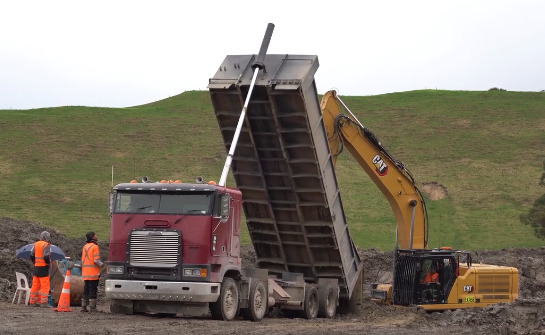Hawke’s Bay Silt Recovery Taskforce lead, Darren de Klerk, has warned work to move around 1,200,000 cubic metres of silt and debris left behind by Cyclone Gabrielle could stall if more funding is not forthcoming.
The Taskforce has moved close to 900,000 cubic metres of silt around Hawke’s Bay, completing over half of the 977 logged jobs in the process.
Mr de Klerk says unless more funding flows by the end of October, work will come to a halt.
“Without confirmation of more funding we will find ourselves at a stand-still again in a few weeks, which means we’ll likely have to wind down the operation due to having no funds,” he said.

Hawke’s Bay Regional Council Chair, Hinewai Ormsby says finding more money for the Taskforce is a high priority.
“We want to reassure the community that we are listening and we know they are hurting and are concerned about the funding of the Taskforce,” she said.
“We know that the Silt Recovery Taskforce mahi is far from done. We asked for $200 million in March, and estimate we still need $70 million to complete the work.
“We appreciate the money Government has given us to date for this important mahi, but we see the reality ahead of us and are advocating for more funding after the election,” said Chair Ormsby.
Hastings District Council Mayor, Sandra Hazlehurst says she continues to push for more Government assistance for silt and debris removal.
“We have been upfront with Government from March about how much money we estimated we needed to clean up the silt from around our rohe, and we still have work to do,” says Mayor Hazlehurst.
“We are engaging with both major political parties in the lead up to the election to make sure it’s an immediate post-election priority for the incoming government.”
Wairoa Mayor, Craig Little said that in the Wairoa district around 20,000 cubic metres of woody debris material has been stockpiled on the beaches and reserves.
“The recovery work to date has prioritised key recreational areas along the coastline, river mouths, beaches and bridges. This recovered material needs to be either burnt, shredded or transported to a dumpsite to complete the operation. However, additional external funding is needed to complete this work.”
Mayor Little said large stretches of the Wairoa district coastline remain inundated with woody debris which, if left, will likely remobilise and cause further problems to the beaches, river mouths, and infrastructure.
“Completing the removal of woody debris now will assist in mitigating further debris issues, and I urge the government to provide funding for this additional but vital work,” he said.
“People have a right to access their beaches and waterways for recreation and gathering of kaimoana and this needs to be further recognised by the government.”
Hawke’s Bay’s Regional Recovery Agency (RRA) Chief Executive, Ross McLeod said the Agency would continue to work closely with Hawke’s Bay Regional Council, the Government and the Opposition parties over the coming weeks in a bid to secure further funding.

Mr de Klerk said with remaining funding, the Taskforce could only complete around 50 further collections by the end of October.
“Applications for collection requests closed on 6 October with 647 jobs logged for silt collection and 330 jobs logged for wood and waste debris collections,” he said.
“We are hearing from the community the amount of help that is still needed in our rohe, and that this work is critical for the recovery of our economy and getting our land back into production. We will continue to lobby Government after the elections to get more help for Hawke’s Bay.”
He said there were 440 jobs left in the system, with an estimated 1,200,000 cubic metres of silt and debris to be cleaned up.
The Taskforce has recovered over 140,000 tonnes of woody debris and processed approximately 60,000 cubic metres of waste debris.
“The risk of not continuing the work will be widespread and we fear will impact our communities for some time – including the delay of landowners getting their land back into production, loss of jobs from our contractors, and dust which is a risk now and will only worsen heading into an El Nino summer.”
“We hope to be able to continue to can manage the dust risk through continued silt removal and controlled management – at deposit sites along with controls like seeding or sowing land and watering down hotspots to minimise community impacts,” said Mr de Klerk.



